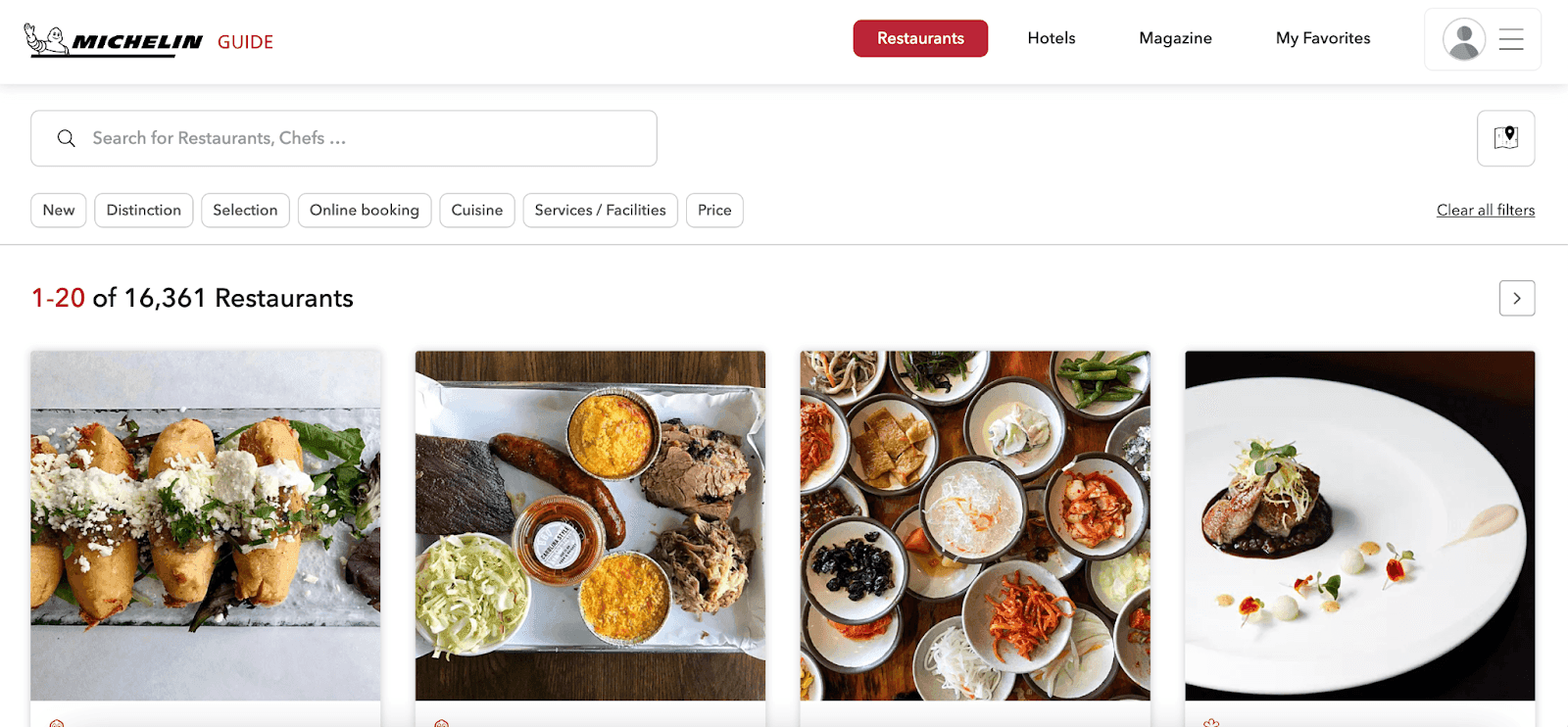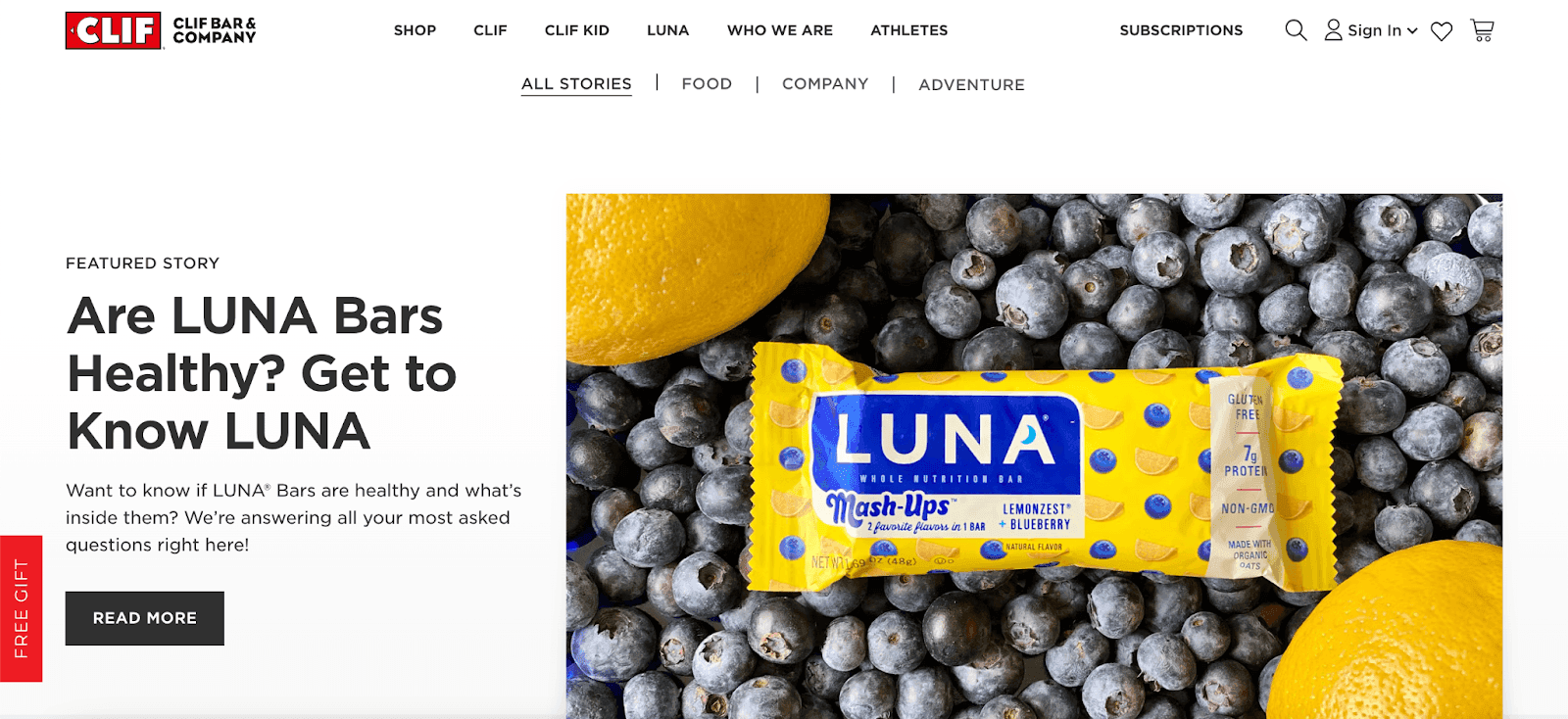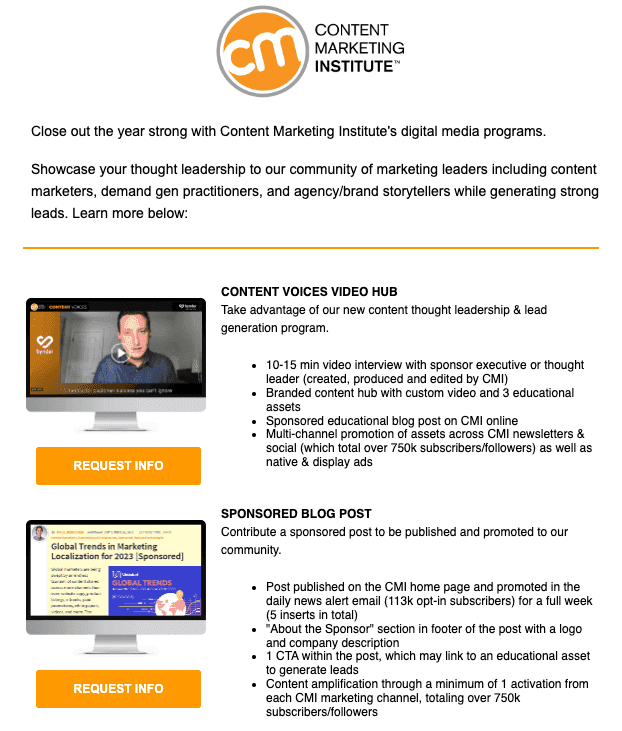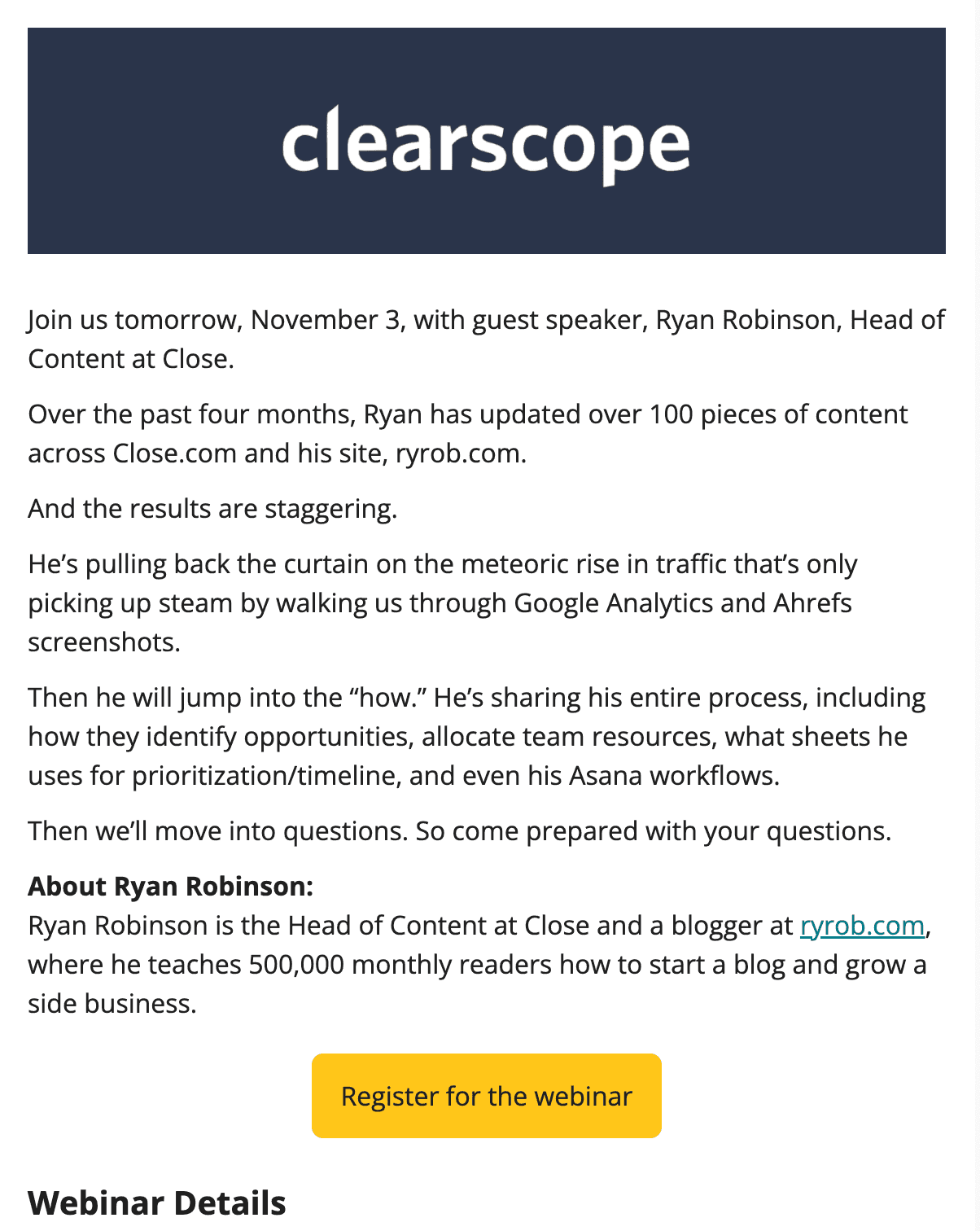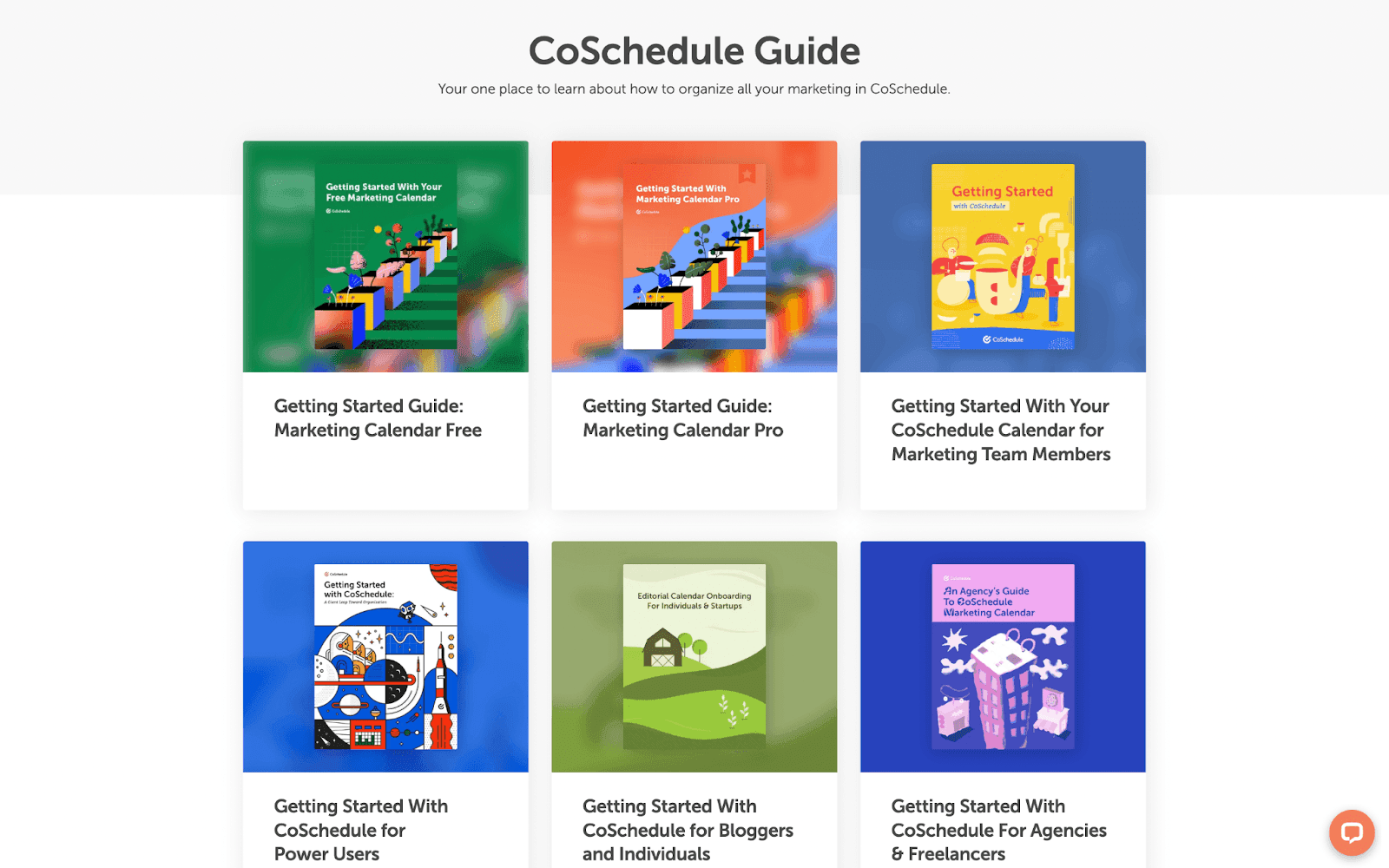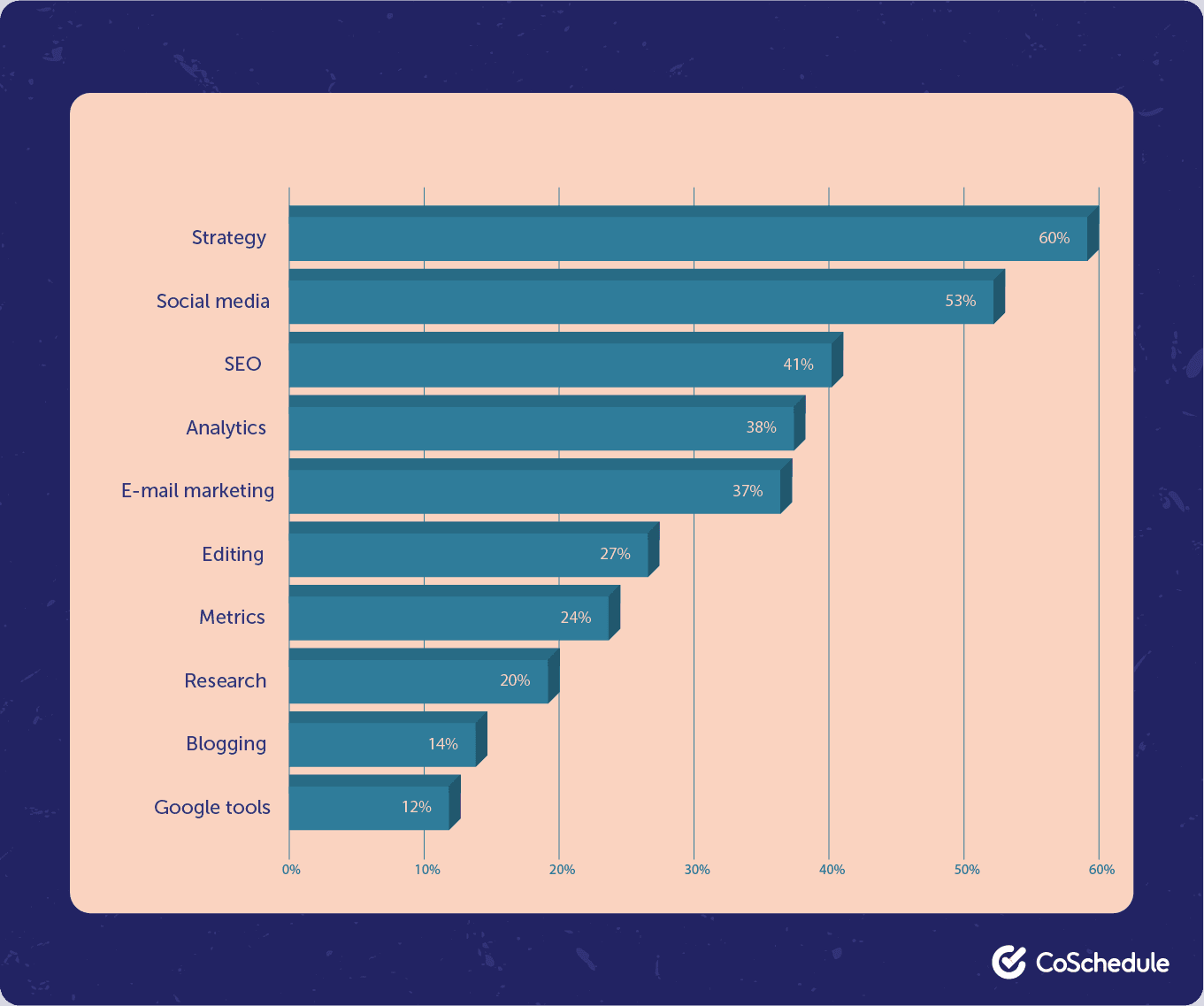Content marketing continues to grow in popularity every day. Data shows why: Content marketing is among marketers’ top-performing projects.
Don’t take my word for it. Influencers in the marketing industry like Marcus Sheridan still believe in content marketing.

But what defines content marketing as an actual marketing discipline? How do you actually plan a strategy and execute it?
That’s where this knowledge base comes in.
What Is Content Marketing?
Content Marketing Definition
Content marketing is the practice of strategizing, creating, publishing, and distributing relevant and valuable information to attract, convert, and retain profitable customer action.
Content marketing often provides helpful, educational, and entertaining information audiences seek out themselves. This differentiates content marketing quite significantly from traditional marketing practices such as advertising, which are disruptive (think of watching a TV show—you want to watch the show, not commercials).
What Isn’t Content Marketing?
If everything on the internet is arguably “content,” then what isn’t content marketing? Here’s a short list of things that it isn’t:
- It’s not about you. This one flies directly in the face of most advertising theories. Ads are always about the company paying for them. Content marketing takes the opposite approach. The content needs to be about your audience.
- It’s not about your product. Content marketing is 100% about helping your customer succeed (using your content). While some content marketing is very good deeper in the funnel for teaching customers how to achieve success with your product, content marketing is not a sales pitch of features and benefits.
- It’s not about instant sales. Content marketing is a long-term strategy for building customer trust and loyalty to a brand or an idea. It isn’t as concerned with an immediate sale. It knows that sales are earned by building customer trust.
- It’s not about creativity. Creativity is king for the advertising world, but not content marketing. Content is all about providing value through education or entertainment.
What Is The Purpose Of Content Marketing?
From establishing your brand as an authority to driving sales, content marketing helps accomplish various goals.
Keep in mind though: all the benefits of content marketing are interlinked. A piece that educates, for example, establishes your expertise and can attract potential customers — even encourage sales or trials of your tool’s freemium version.
Let’s look at these benefits in detail.
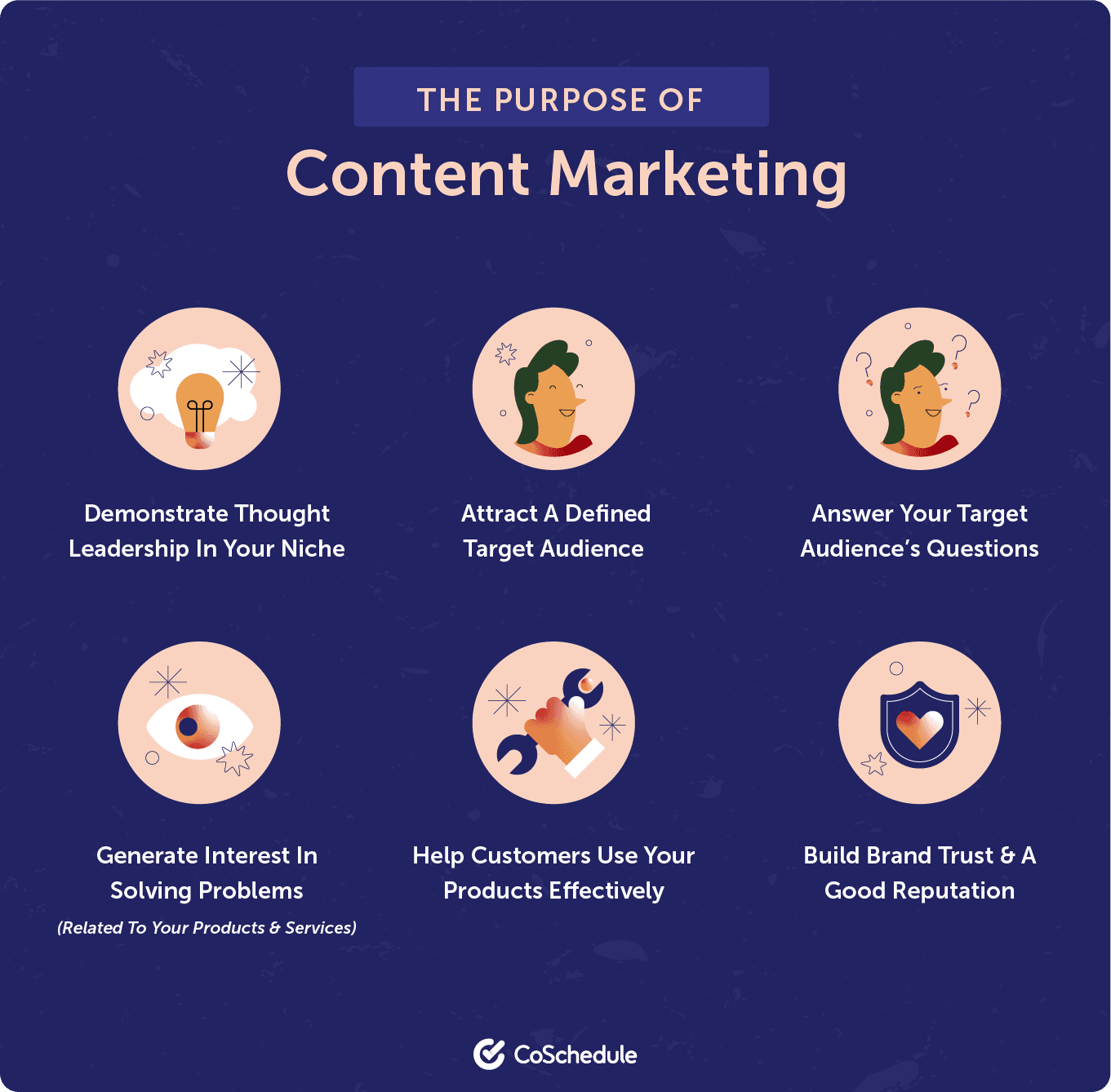
The Purpose Of Content Marketing:
- Demonstrate thought leadership in your niche
- Attract a defined target audience
- Answer your target audience’s questions
- Generate interest in solving problems related to your products and services
- Help customers use your products effectively
- Build brand trust and a good reputation
1. Demonstrate Thought Leadership In Your Niche
Content marketing centers around creating unique, value-sharing content that can be opinionated.
Think of it as a medium to share your specific expertise, experiences, processes, and frameworks — all of which position you as a thought leader, an expert in your field.
2. Attract A Defined Target Audience
The value you offer with your content — whether it’s educational or entertaining gets your audience’s attention, driving traffic to your business.
By publishing helpful content regularly, you can not only build brand awareness but also grow a loyal following, which ultimately, helps grow sales.
3. Answer Your Target Audience’s Questions
Content marketing aims to answer questions your ideal buyers have at each step of their buyer’s journey with you.
You start off by answering questions your target audience has related to the problem you solve. As the funnel progresses, create content related to questions your audience has about how your product/business solves their problems and why it’s an ideal tool for them. Finally, for the last stage, use content to encourage interested consumers to buy from you.
4. Generate Interest In Solving Problems Related To Your Products & Services
Content marketing helps you create awareness of problems people don’t realize they have. In that: you can create new demand as ‘conversational marketing’ — a term they coined to define the solution their audience didn’t realize they needed.
5. Help Customers Use Your Products Effectively
Product-led content assists in educating your audience and customers about using your product to drive the best results from it.
Content piques interested folks’ interest in your product by demonstrating what your tool can do and how it can help them. On the other hand, product tutorials help paying users better use your product — optimize playing with features they use and explore new features they didn’t know about.
6. Build Brand Trust & A Good Reputation
With all the education and value your content bank offers, you can slowly but surely gain your audience’s trust. Once you have your buyers’ trust, you can grow sales, positive word of mouth, and referrals.
Ultimately, by sharing your expertise and answering your audience’s questions, you can build a strong reputation for yourself.
What Are Examples Of Content Marketing?
The practice of content marketing is older than the name itself, which may prove that the work matters more than what you choose to call it.
- John Deere has published a magazine called The Furrow to help farmers succeed since 1895.
- Michelin has published Michelin Guide to help travelers find good restaurants since 1926.
- Clif Bar publishes blog content to help athletes make healthy decisions.
1. John Deere Launches A Revolution With The Furrow
One of the most classic examples of content marketing, and one of the longest-running content marketing plays in history, is John Deere’s publication The Furrow.
First published in 1895 as “a Journal for the American Farmer,” The Furrow began as a printed newsletter sharing information about agriculture.
Today, it exists as a digital magazine on the John Deere website and continues to provide all kinds of information that people who might buy John Deere equipment would want.
How has The Furrow managed to remain successful for more than 100 years? There are a few simple principles of content marketing that can account for its enduring appeal:
- It focuses on educating over selling. No one wants to be sold before they’re ready to buy. But everyone wants information that helps them do their work and solve problems more easily. The Furrow focuses on making its audience smarter and more capable through useful and authoritative articles that establish trust.
- It’s written by subject matter experts. Sure, it’s a piece of marketing collateral. But it’s also written by people who know what they’re talking about. If it weren’t, it wouldn’t feel as authentic.
- Education + Expertise = Trust (And Sales). The Furrow wouldn’t continue to earn investment from John Deere unless they knew it helps drive sales. Which it does by building a relationship with its consumers. By creating a publication that readers make a habit of reading, they occupy a place in their lives that a 30-second advertisement never could.
For many modern marketers, these points may feel obvious, especially if you have experience creating content already. This is just how marketing is done these days, right?
While other types of marketing remain important (including advertising, outbound sales, and other disruptive forms of marketing), it’s true that content has forever changed how consumers connect with brands.
2. Michelin Stars Helps Travelers Discovery High-Quality Restaurants
The Furrow is the one classic example of content marketing that everyone points toward whenever this topic comes up. But there are plenty more timeless content marketing examples that we can learn from, as well as tons of current examples all around us (and some that we don’t typically think of as being content marketing at all).
You’ve heard of Michelin Stars, right? They’re awarded to restaurants as a measure of quality, and they’re highly coveted because of how well they can burnish a dining establishment’s reputation.
Michelin Stars were created by the Michelin tire company as part of its Michelin Guide, which started as a guide to places to eat for people going on road trips. Before smartphones, Yelp, and Google Maps were a part of people’s lives, it was essential for cross-country travel. It still exists today as a website.
It might not make sense for a tire company to create restaurant guides and rating metrics. But when we consider the fact that people traveling needed that information, and people were traveling in their own cars (which would eventually need tires), it makes perfect sense.
Offer value first. The rewards for your brand will come later.
3. Clif Bar Helps Consumers Make Healthy Decisions
Today, all kinds of brands and companies are creating content and attracting audiences. Whether they’re B2B, B2C, or a mix of both, it’s clearly catching on.
Take a look at Clif Bar & Company.
What could an energy bar company want to blog about? All kinds of things related to topics that someone interested in energy bars might also be interested in. That includes healthy recipes, other snack ideas, nutrition tips, and more. It’s on par with almost any blog someone interested in those topics might read, whether it’s from a brand or not.
What Are The Types Of Content Marketing?
Content marketing may exist to educate and entertain a target audience at any stage in the buyers’ journey.
- Native marketing: Paid placements for helpful, educational, and entertaining content are a way to reach an unaware audience who doesn’t know your brand, products, or services.
- Inbound marketing: This type of content marketing exists to attract a target audience to your brand, product, or service, often through search engine-optimized content and social media/word of mouth virality.
- Sales enablement: Content that enables sales teams and prospective customers who are “self-serving” their own education during their buying process.
- Customer enablement marketing: After converting a customer, content marketing presents opportunities to onboard, expand use cases, and ultimately teach customers how to be successful with your products and services.
- Original research: Content marketers may publish proprietary datasets to aid in all stages of the buyers’ journey as collected through product and service usage, target audience surveys and polls, and even collaborating with third-party research businesses.
At CoSchedule, we consider this a shortlist of the types of content marketing. That said, all of these types of marketing may leverage a variety of types of content.
For example, content marketers may publish original research via a “State Of” report landing page, blog post, video, social media posts, and more. Check out this comprehensive resource if you’re interested in learning more about content types specifically.
1. Native Content Marketing
Also known as sponsored content, sponsored publishing, and branded content, native marketing allows content marketers to buy placements in publications to reach target audiences through channels they don’t own.
Examples of native content marketing include blog posts, articles, podcasts, and conference speeches.
2. Inbound Marketing
Inbound marketing creates valuable content aligned to your target audience’s needs to drive them to your site. Content is often search-optimized, which makes search engines like Google, the primary channel that inbound marketing uses, bring customers to your site.
Examples of content types to produce for inbound marketing include blog posts, ebooks, video series, podcasts, webinars or masterclasses, and visual content such as infographic.
3. Sales Enablement
Sales enablement involves creating internal content for educating sales teams and external content for the sales process that helps salespeople reach out to, engage, and convert buyers.
Examples of sales enablement content types include case studies, product cheat sheet, outreach email templates, battle cards, sales playbooks, video testimonials, white papers, and buyer personas.
4. Customer Enablement Marketing
This includes creating content to improve customer experience by educating them on how to use your product/service better.
Example content types that improve customer enablement include onboarding manuals or emails, ebooks, videos, webinars on product education, email course, and webpage corner as in the example below:
5. Original Research
Original research taps into researching an industry pain point that has little to no data on it to provide data-backed value to readers. Tap into your network or community to survey people for doing original research or collaborate with a third-party research service.
Content types to produce here are research reports, data-backed blog posts, web pages, guest posts, social media posts, videos, and infographics. In fact, you can repurpose the data points from your report in multiple ways including email, blog, and social content.
What Are The Rules Of Content Marketing?
Success in content marketing is best guaranteed when you follow these ten simple ground rules.
10 Rules Of Content Marketing:
- Commit for the long-term
- Follow a unified strategy
- Provide value
- Be relevant
- Be unique and avoid copycatting
- Invest in designs and visuals
- Publish consistently
- Measure results
- Iterate and optimize content you’ve already published
- Be patient
1. Commit For The Long-Term
Unlike running digital ads, content marketing doesn’t deliver overnight results. This is particularly true for inbound marketing as pages are slow to rank in Google. Its why long-term investment is one of the foundational rules of content marketing.
It encourages you to produce a content gallery that answers your target audience’s burning questions. In turn, the content drives traffic to your business, establishes you as an expert, and builds brand familiarity and loyalty — ultimately leading to sales.
2. Follow A Unified Strategy
An integrated content marketing strategy ensures all the content from your brand is focused and consistent (follows the same values and voice). It also ensures your efforts are directed toward a defined goal(s), which yields better ROI.
However, to make sure your entire team is aligned on the type of content to publish across various marketing channels, document your content strategy. Doing so brings everyone on the same page and also increases your chances of success by 538%.
3. Provide Value
The value (usefulness) your content offers is your gateway to getting your audience to remember your brand, come back to you for more, engage with you, and convert. It’s also how you can grow your word of mouth.
No wonder 87% of B2B marketers prioritize their audience’s informational needs over the organization’s sales/promotional message.
4. Be Relevant
Relevancy helps your content stand out and speak to your target audience. It tells your content consumers that you understand them which is why you’re well-positioned to help them.
The key to being relevant? Regularly talking to your audience to understand their interests, struggles, and the language they use.
5. Be Unique & Avoid Copycatting
With 82% of marketers actively investing in content marketing, it can be hard to stand out in the crowded space. One surefire way to cut through the noise, however, is working out a value proposition for your content.
Some ideas for a value proposition include using a unique voice and sharing frameworks and templates that have worked for you.
At CoSchedule, for instance, we aim to make all content actionable. It’s why we try to leave our readers with an action plan for the next steps to take using the templates and checklists we share with most of our content.
6. Invest In Designs & Visuals
Not many content teams create the effort to create branded visuals, making visuals a simple yet effective way to stand out.
Easy to read visuals and a user-friendly design also make content easily digestible, which increases the value you offer. Image SEO offers better content ranking opportunities too. Not to mention, using branded colors in your visuals and design grows your brand recognition by 80%.
7. Publish Consistently
Following a regular publishing consistency sets your audience’s expectations. In turn, this assists in achieving your content goals and driving better results.
Regular publishing consistency also grows the traction your content gets and helps you build internal links in inbound marketing, which improves your SEO performance.
8. Measure Results
The results you track will depend on the goals you set, which, in turn, depend on the maturity of your content marketing plan.
In the early stages, for example, aim to grow your brand awareness. To that end, track progress using metrics like keyword ranking, the traffic you’re driving, the impressions your content is getting, the click-through rate, and backlinks its earning.
In certain instances though, it can be tough to calculate the ROI of content marketing. Here’ s how the Ahrefs’ CMO, Tim Soulo puts it:
Let’s talk about the “ROI of Content Marketing.”
Far too often us marketers get challenged with this question by our boss (or our client):
– How do I know that my investment in content will guarantee a positive return? …& how can I *MEASURE* it?
[Read more..]
— Tim Soulo ???????? (@timsoulo) March 23, 2021
9. Iterate & Optimize Content You’ve Already Published
Improve the depth and comprehensiveness of the content you create. Cut out sections that don’t add value or contribute to the content’s fluff.
Also, make sure your content is fresh in terms of the research and data it cites and in providing the best answer to the questions your target audience is asking.
All of this ensures the content you’ve published continues providing value to its consumers down the line. It also improves your content’s performance. The team at Single Grain, for example, updated their blog content and saw a 96% increase in their traffic.
10. Be Patient
Patience is key to success in content marketing. In fact, long-term, consistent investment takes patience — same as producing value-packed, high-quality content that often doesn’t show results right away.
What Are The Steps Of Content Marketing?
There’s a lot that goes into content marketing including strategizing, ideating, and more. Here’s a breakdown.
The Steps Of Content Marketing:
- Begin with strategy
- Vet ideas
- Conduct research
- Create content
- Measure results
1. Begin With Strategy
Plan your work, then work your plan. This simple saying has long driven the work we do at CoSchedule, and the results speak for themselves.
This starts with strategy. At a high level, this entails figuring out the following:
- Who are you trying to reach? These are your potential customers.
- Why are you trying to reach them? You’d like them to buy from you.
- What would you like them to do? Again, you want to land more sales.
This is ultimately what you’re trying to accomplish, but it’s a bit … me-centered. In order to be successful, the focus has got to be put back on the customer. Let’s try rethinking these three bullets another way:
- Who are you trying to help? This is your potential audience.
- Why are you trying to help them? Because your products or services are the best solution to meet their needs and solve their problems.
- What would you like them to achieve? To become better versions of themselves.
This might sound like some feel-good mumbo jumbo, but if you’re actually committed to developing the kinds of long-term relationships that build long-term businesses, this is the way to think about it.
If you can nail the second set of bullets, you can achieve the first set of bullets with much less effort. It’s a virtuous circle that stems from what Brett McGrath at The Juice calls having an “abundant mindset”:
- Developing personas: Understand your audience by doing your research and developing basic character descriptions for who you’re attempting to attract.
- Crafting messaging: What core messages about your products or services does your content need to convey?
- Selecting channels: Which are best to reach your target audience?
2. Vet Ideas
Content marketing is driven by ideas. In order to maintain a consistent publishing pipeline that provides continuous value for your customers, you’ll need plenty of ideas.
- Content ideation: You’ll need to create a bank of ideas and learn how to prioritize them.
- Content mapping: Align content ideas with each stage of the funnel.
- Content calendar: Plan your publishing schedule on your content calendar.
Recommended Reading: Content Calendar Template
3. Conduct Research
Content marketing relies on research:
- Industry research: Marketers aren’t always experts on the industries their companies operate in. At least not at first. You’ll need to do your homework.
- Product research: If you’re not a subject matter expert, you’ll need to learn who is within your organization.
- Competitive research: Follow your competition (but not too closely).
- Topical research: Develop an understanding of the topical areas your content needs to cover.
- Keyword research: Uncover what people are searching for and create content around their interests.
4. Create Content
Executing content marketing requires several different roles (not necessarily formal job titles, but specific groups of tasks and responsibilities).
- Strategists: Who determines what you’ll do and why?
- Writers: Who’s going to write all those words that serve your audience?
- Audio/Videographers: Who will interview and record subject matter experts?
- Editors: Who will make sure your content is crisp, clear, and clean?
- Designers: Who will make that content look awesome?
- Analysts: Who will determine whether your content is delivering ROI?
- Managers: Who’s got their hand on the wheel to steer the whole content ship?
5. Measure Results
Content marketing can be challenging to measure, particularly at the top of the funnel, where it’s difficult to connect activity that drives awareness directly to revenue.
But you do need to understand how to measure the impact of your work from the top of the funnel all the way down. This is essential for understanding how content marketing is actually helping to build your business.
Without numbers to show progress and prove results, it will be impossible to get the buy-in and investment you need to be successful in the long-term, too.
This will entail:
- Setting goals: What are the numbers you need to reach?
- Determining metrics and KPIs: Which numbers will you track to measure progress toward goals?
- Reporting: How will you share with your organization how your content marketing is performing and helping to drive growth?
What Does A Content Marketer Do? An Overview Of The Content Marketing Process
A content marketer is responsible for executing the content marketing process, which includes tasks like content planning, writing, editing, optimizing, and more.
Executing content marketing requires several different roles (not necessarily formal job titles, but specific groups of tasks and responsibilities).
- Strategists: Who determines what you’ll do and why?
- Writers: Who’s going to write all those words that serve your audience?
- Designers: Who will make that content look awesome?
- Editors: Who will make sure your content is crisp, clear, and clean?
- Analysts: Who will determine whether your content is delivering ROI?
- Managers: Who’s got their hand on the wheel to steer the whole content ship?
The work these teams do can be quite varied. Here’s a breakdown of the most in-demand skills for content marketers according to data gathered by Statista in cooperation with SEM Rush:
Let’s dive into the steps of the content marketing process one by one below.
1. Strategize
All good content marketing starts with thorough planning that aims to create an audience-first strategy. The strategy, in turn, directs your efforts — increasing your odds of success.
Questions Content Marketers Ask Themselves When Strategizing:
- What questions do prospects and customers ask your customer service folks?
- What visuals would your target audience find helpful, such as flowcharts and diagrams?
- What unique perspectives drive your business’s problem-solving?
- What words and terms do prospective customers use when they describe the solutions they’re seeking? What synonyms may exist for these queries?
- What keywords would your target audience use to find a resolution to the problems your product or service solves?
2. Ideate
This includes coming up with topics to create content on for all your publishing channels. The audience research you do for creating your content strategy and the conversations you’ve had with your customer-facing teams will help spark content ideas.
Ideally, aim to pick out ideas that are relevant to your audience and those that offer business value to you (i.e. are relevant to your product or service offering or the space you are in).
Questions Content Marketers Ask Themselves When Ideating:
- What type of content would be the best to tell this story?
- How may you provide more value to your target audience than any competitor?
- How may you position your business as the leading authority on this topic?
Recommended Reading: Must Have AI Content Marketing Tools That Change The Game
3. Research
Content marketers do a lot of research — both before creating a strategy and after it, as they plan individual content topics. Research work includes:
Industry research
The aim is to learn about the different content types already being produced and how good they are. To find out, ask yourself:
- What type of content is already being created?
- What’s good about it and what’s lacking?
- What sort of results is it driving?
At the end of this research, you should be having a swipe file of good ideas that you can use.
Competitor research
Study your competitors’ strengths and weaknesses to understand what opportunities are available to you. Questions to ask here include:
- What types of content are our competitors creating?
- How is the content doing for them?
- Which marketing channels or content distribution channels are they using?
- What is their content’s value proposition?
- What’s something you can do that they can’t?
See if you can identify the strategy they’re following. Some may be taking a community-first approach, for example. Others might be focused on producing a few content pieces but repurposing them for maximum exposure
Product research
This is specifically helpful for SaaS brands invested in creating valuable product-led content. For conducting this type of research regularly, sync with your product team to learn about the product.
Create a product cheat sheet so you use it to reference product features to mention in your content and to educate your team about the tool.
Topical and keyword research
And finally, dig into what’s already covered about the topic you’re aiming to cover and which keyword you can use. Ask yourself:
- What’s already covered on the topic and what keywords is it using?
- How can you make it better or add your unique take to it?
- What unique angle can you take to stand out and drive results?
- Is the keyword you are targeting highly competitive? How likely are you to rank for the keyword?
4. Write
Reference all the research work you’ve done to create content that speaks to your audience and shows your expertise.
If you’ve the budget, you can also outsource content writing. In that case, you’ll need to share your documented research work in a creative brief that captures your expectations from the piece.
5. Record
Recording podcasts and videos (educational tutorials, marketing videos, and webinars) takes extensive planning. Begin with deciding the content format, then research the topic, and write a script before you start recording.
6. Design
As with writing, content marketers with a budget can outsource design to an in-house or freelance illustrator or designer. Alternatively, you can also use branded templates for social media, email, and blog graphics to save time and maintain design consistency.
7. Edit
Content marketers need to edit all the content they produce — no matter its format (written, audio, or video) for:
- Clarity. Is everything that you’re saying easy to understand?
- Brevity. Are you using just enough words to get your point across?
- Accuracy. Are all the facts and research you’ve shared correct?
- Brand consistency. Is the content aligned with your business values? Are you using your brand voice? Does the content follow your brand’s style guide?
8. Publish
Creating a publishing checklist ensures you don’t miss any of the small tasks that go into publishing content. It’s also effective to use a content calendar to stick with a publishing schedule and hold yourself accountable for publishing regularly.
9. Promote
Content distribution is as important as content creation as it gets your work in front of the people you’re targeting.
You can always bake distribution into production by identifying snippets to share on social and snippets to repurpose. Other ways to distribute the content you publish include:
- Share it on your social channels
- Write an email and share with your email list
- Create a short video
- Do a webinar
- Host a Twitter Space
- Guest post on the topic
10. Measure
Measure your content’s performance against the metrics or key performance indicators (KPIs) you’ve set. For instance, study how well the content is ranking and what traffic and conversions it’s driving.
You can also use a website analytics tool like Hotjar (nofollow) to review the areas on your blog that get the most views and clicks and the areas where readers are bouncing off. You can set up feedback surveys with it as well to learn how helpful your content is directly from your readers. All this helps you create better content design and improve your conversion rate optimization.
11. Report
Content marketers are also responsible for updating stakeholders about the content’s performance and the expected and achieved ROI. This includes communicating which content types and channels are driving the best results and future plans based on it.
12. Iterate
Regularly evaluate how well your content plan is doing. Based on what you learn, content marketers are responsible for deciding how to improve their content campaigns. Three questions that’ll guide you in this step are:
- What results is the content driving — are they the desired results or better?
- What content topics, formats, and types get the most engagement from your target audience?
- What actions do you plan to take moving forward — scrap an initiative after having given it ample time, invest more resources into it, or continue with the same plan of action?
.
This piece was originally written by Ben Sailer and published December 1, 2021. It was updated October 11, 2022. It was most recently updated significantly in March 2023. Ben Sailer and Nathan Ellering contributed to the writing of this piece.


